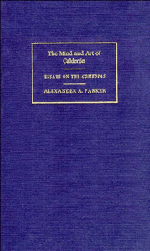Book contents
- Frontmatter
- Contents
- Author's preface
- Editor's preface
- Introduction
- I Stylistic and dramatic craftsmanship
- II From experience to myth
- III The tensions of social life
- 11 The functions of comedy
- 12 The vicissitudes of secrecy (1): La dama duende, El galán fantasma
- 13 The vicissitudes of secrecy (2): El astrólogo fingido
- 14 Secret betrothals and secret marriages: El postrer duelo de España
- 15 From comedy to tragedy: No hay cosa como callar
- 16 A Calderonian conception of tragedy: El pintor de su deshonra
- 17 The tragedy of honour: El médico de su honra
- IV The tensions of public life
- V From symbol to myth
- Epilogue
- Notes
- Index
17 - The tragedy of honour: El médico de su honra
Published online by Cambridge University Press: 05 February 2012
- Frontmatter
- Contents
- Author's preface
- Editor's preface
- Introduction
- I Stylistic and dramatic craftsmanship
- II From experience to myth
- III The tensions of social life
- 11 The functions of comedy
- 12 The vicissitudes of secrecy (1): La dama duende, El galán fantasma
- 13 The vicissitudes of secrecy (2): El astrólogo fingido
- 14 Secret betrothals and secret marriages: El postrer duelo de España
- 15 From comedy to tragedy: No hay cosa como callar
- 16 A Calderonian conception of tragedy: El pintor de su deshonra
- 17 The tragedy of honour: El médico de su honra
- IV The tensions of public life
- V From symbol to myth
- Epilogue
- Notes
- Index
Summary
At the beginning of the previous chapter, when discussing the allegedly untragic Spanish treatment of honour we noted the opinion that ‘the Spanish preoccupation with honour was a particularly unworthy motive for writing a tragedy, since it did not emphasise the injustices of life but exalted the self-righteousness of the arrogant obsession of an individual with his own reputation in the eyes of others’. The analysis of El pintor de su deshonra will, it is hoped, have shown how badly misunderstood the play had been if it had given rise to such a total misconception. The play now to be considered was for long the stumbling-block par excellence in the understanding of honour in general and of Calderón in particular. This is due in large measure to the fact that here the husband's murder of his innocent wife is due not to a passionate impulse but to a coldblooded and carefully calculated attempt to comply with one aspect of the code of honour concerning the need for vengeance. Since dishonour destroyed one's public reputation, honour could only be restored by an equally public act of vengeance: honour had not only to be restored, but to be seen to be restored. If, on the other hand, a man's dishonour was not publicly apparent, the act of vengeance had to be secret in order not to publicise what vengeance was intended to remove. This requirement led dramatists to devise ingenious and sinister ways of accomplishing the act of wife-murder, as part of the dramatic demand for ‘surprise’ in the solution.
- Type
- Chapter
- Information
- The Mind and Art of CalderónEssays on the Comedias, pp. 213 - 238Publisher: Cambridge University PressPrint publication year: 1989
- 1
- Cited by



